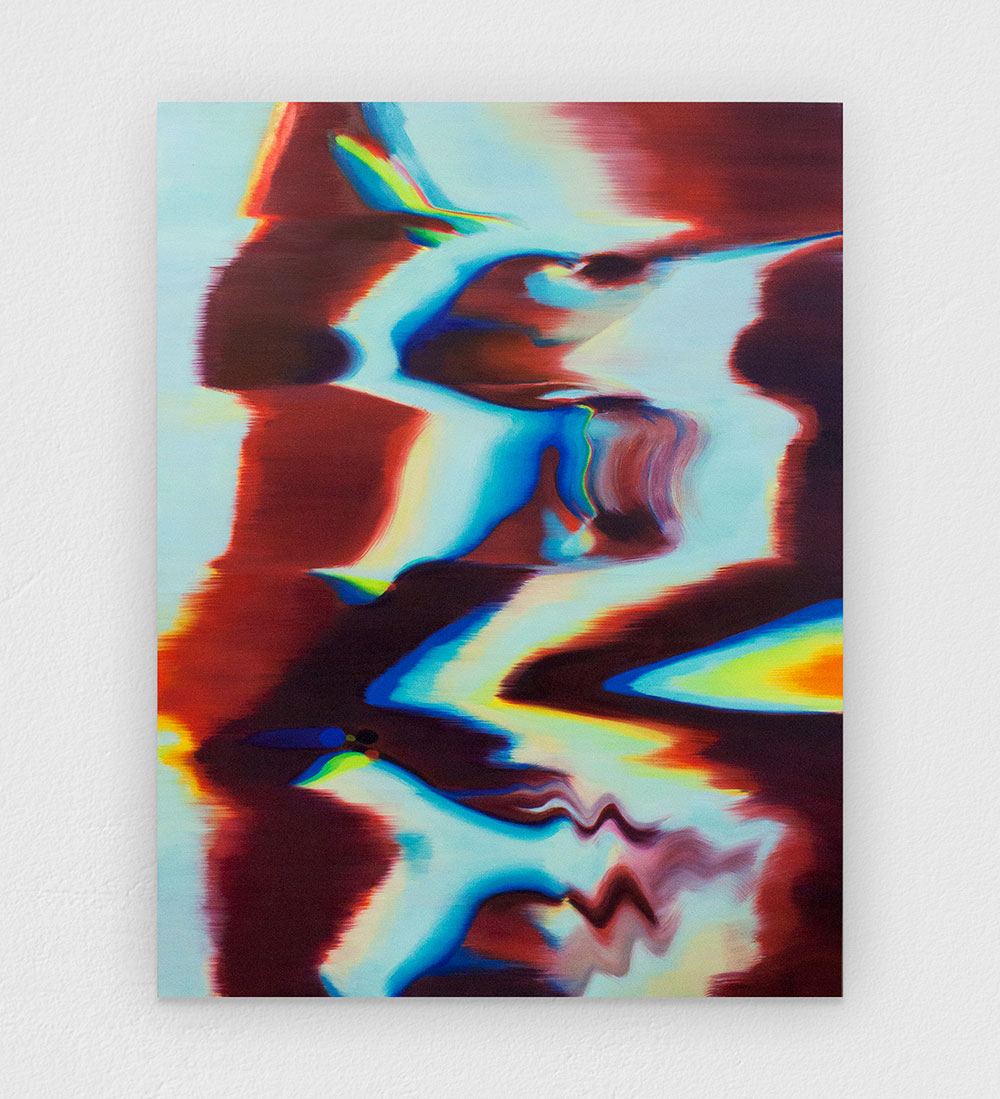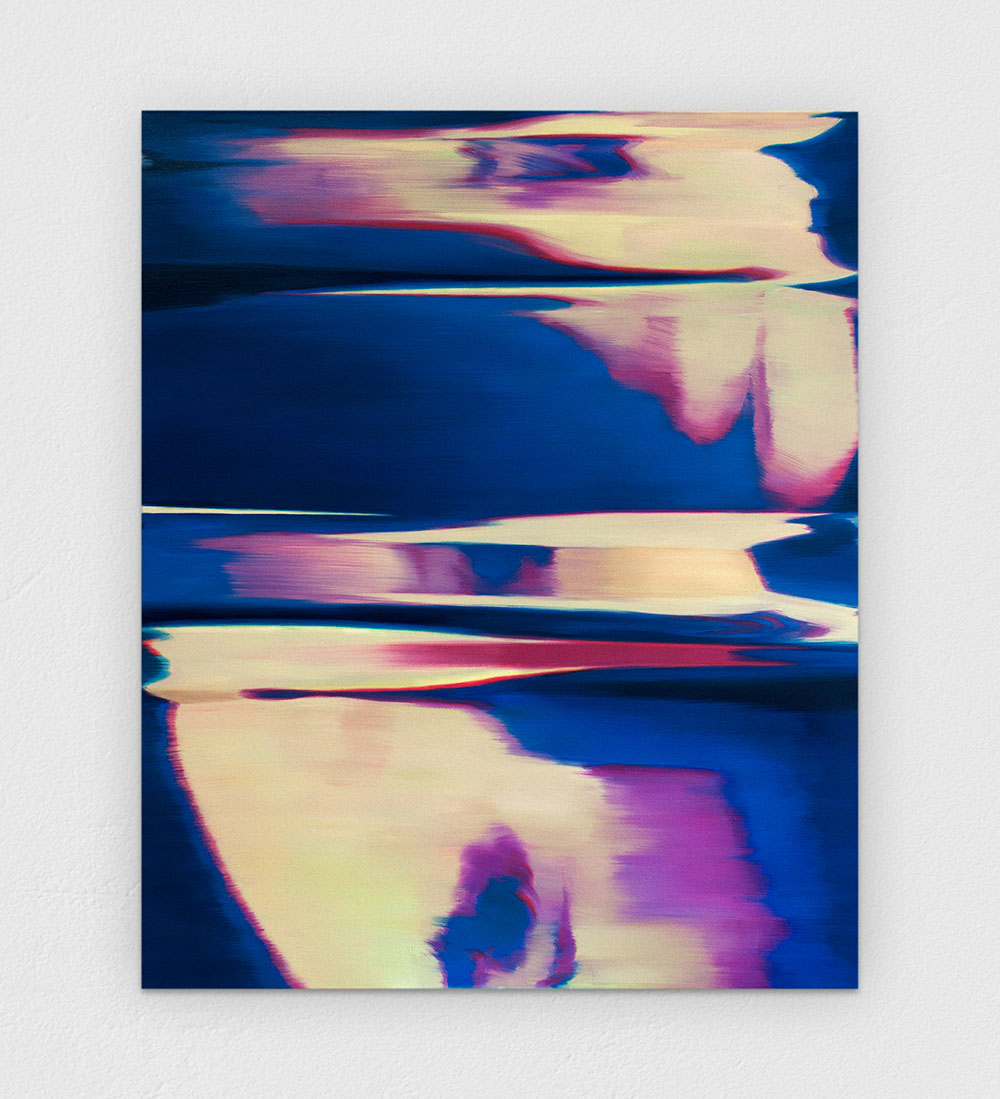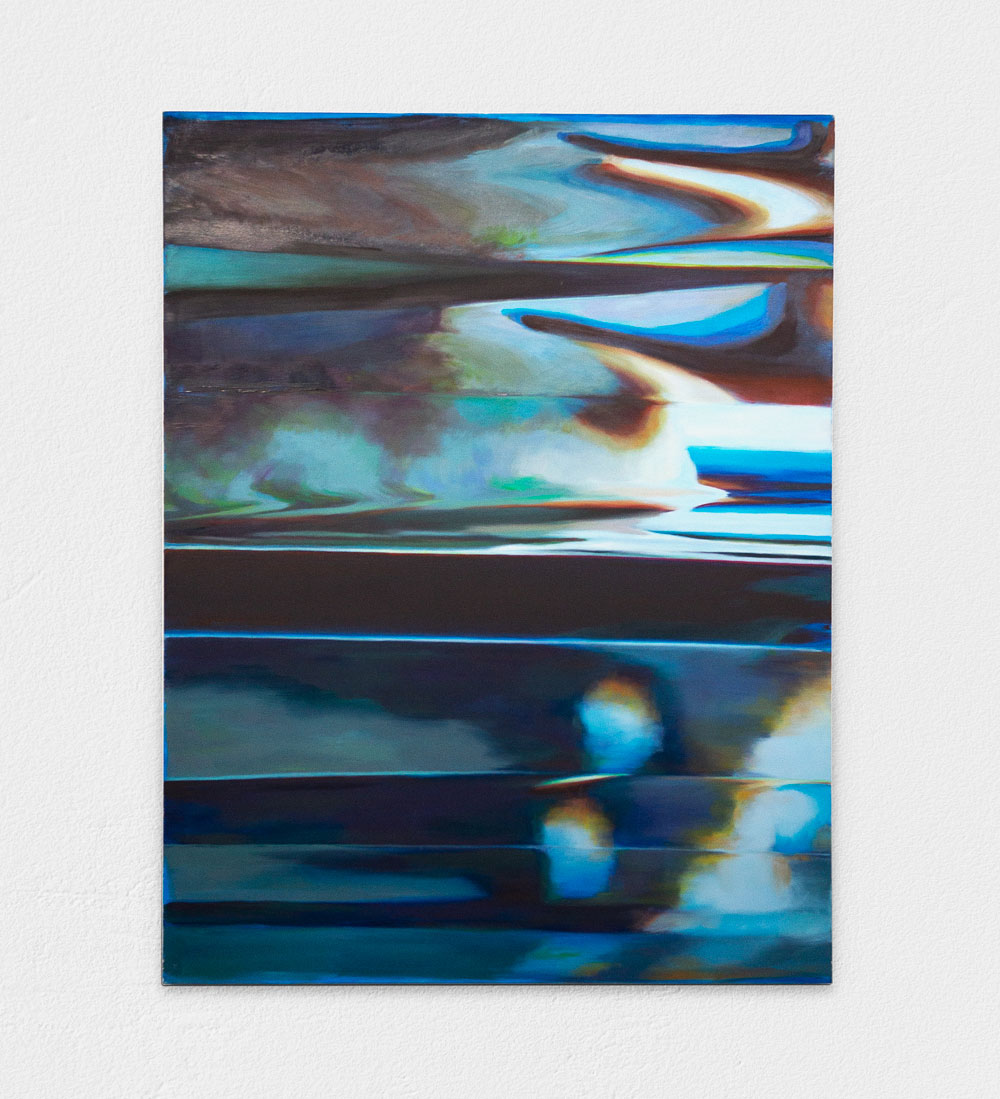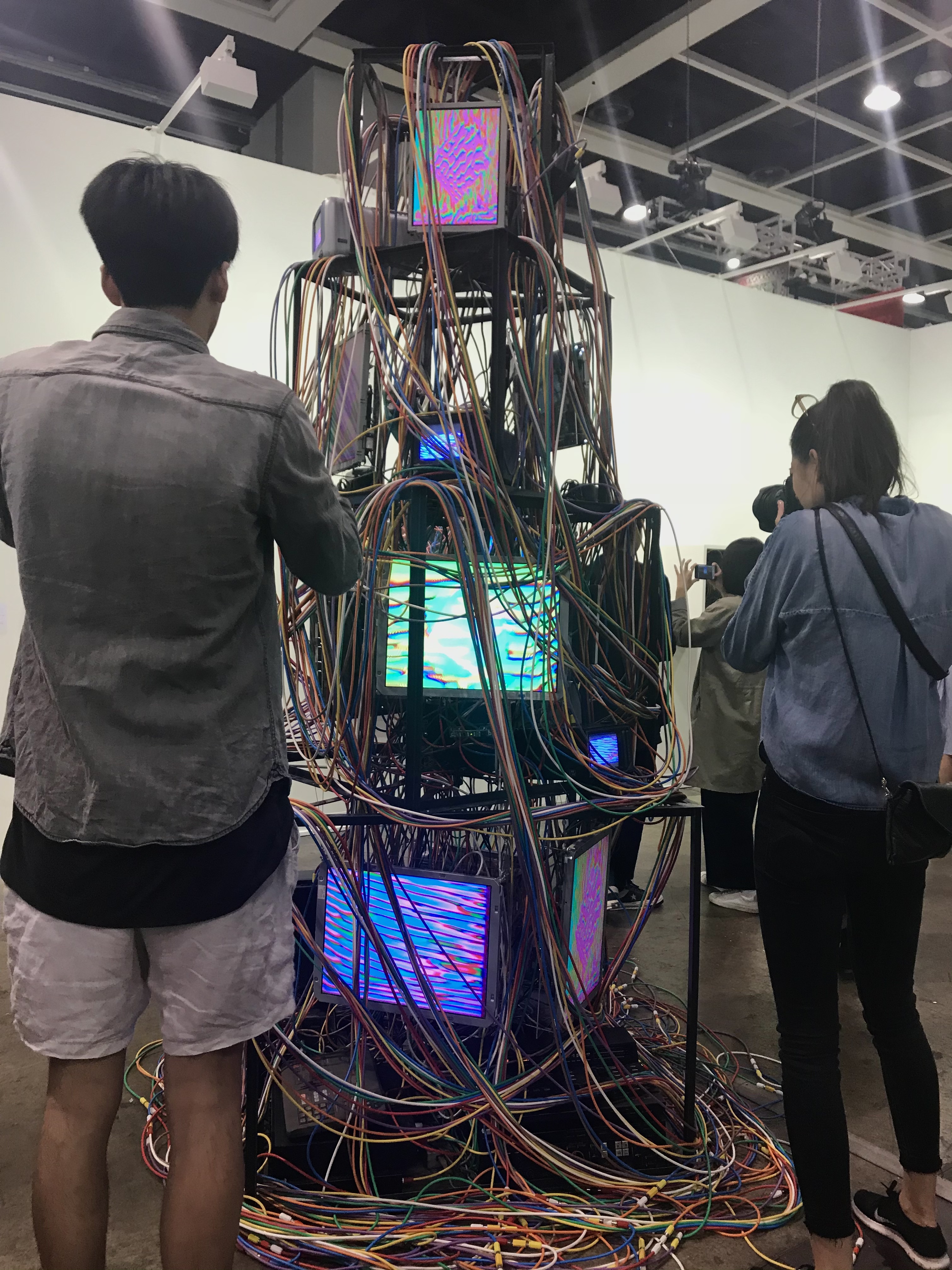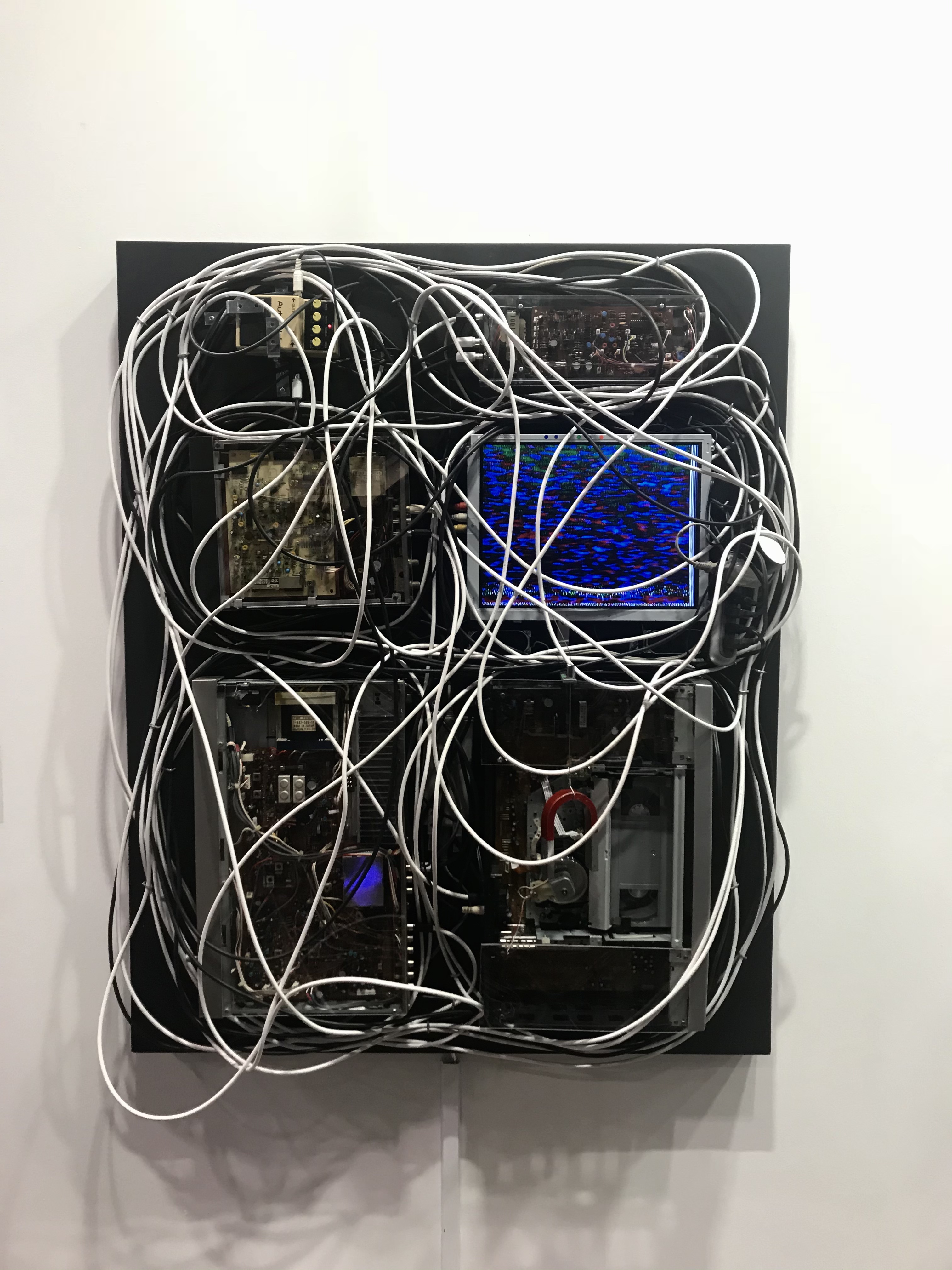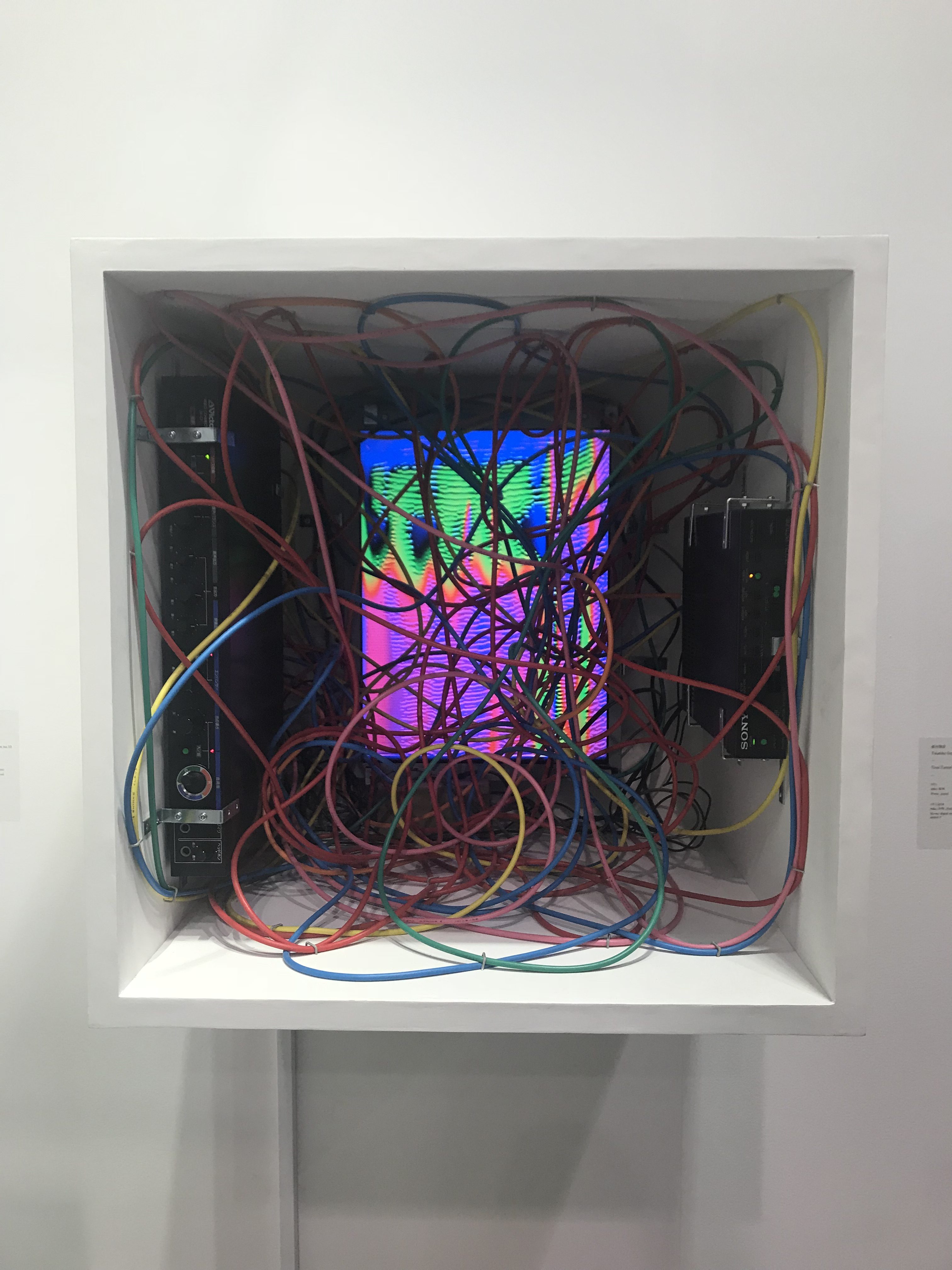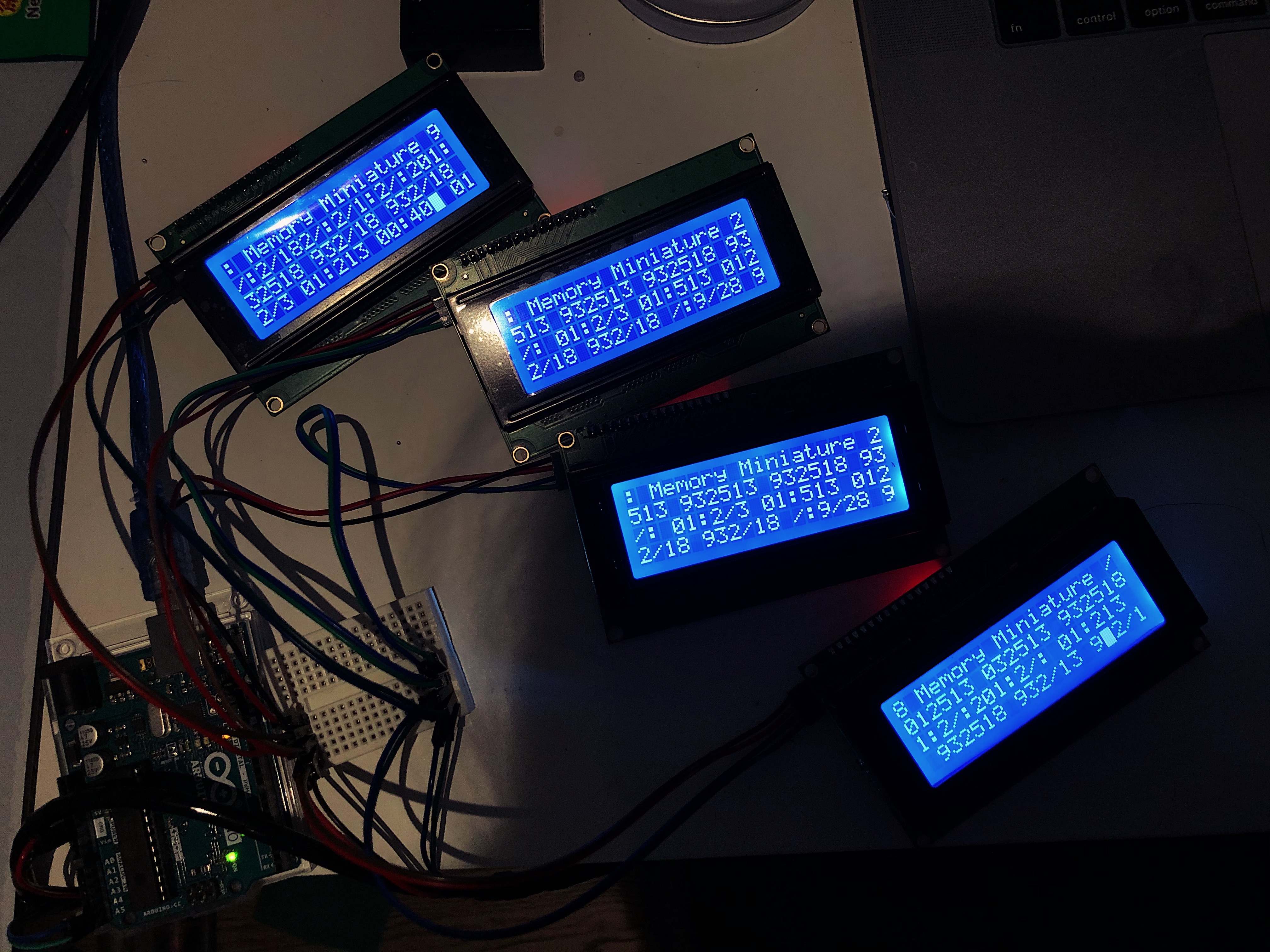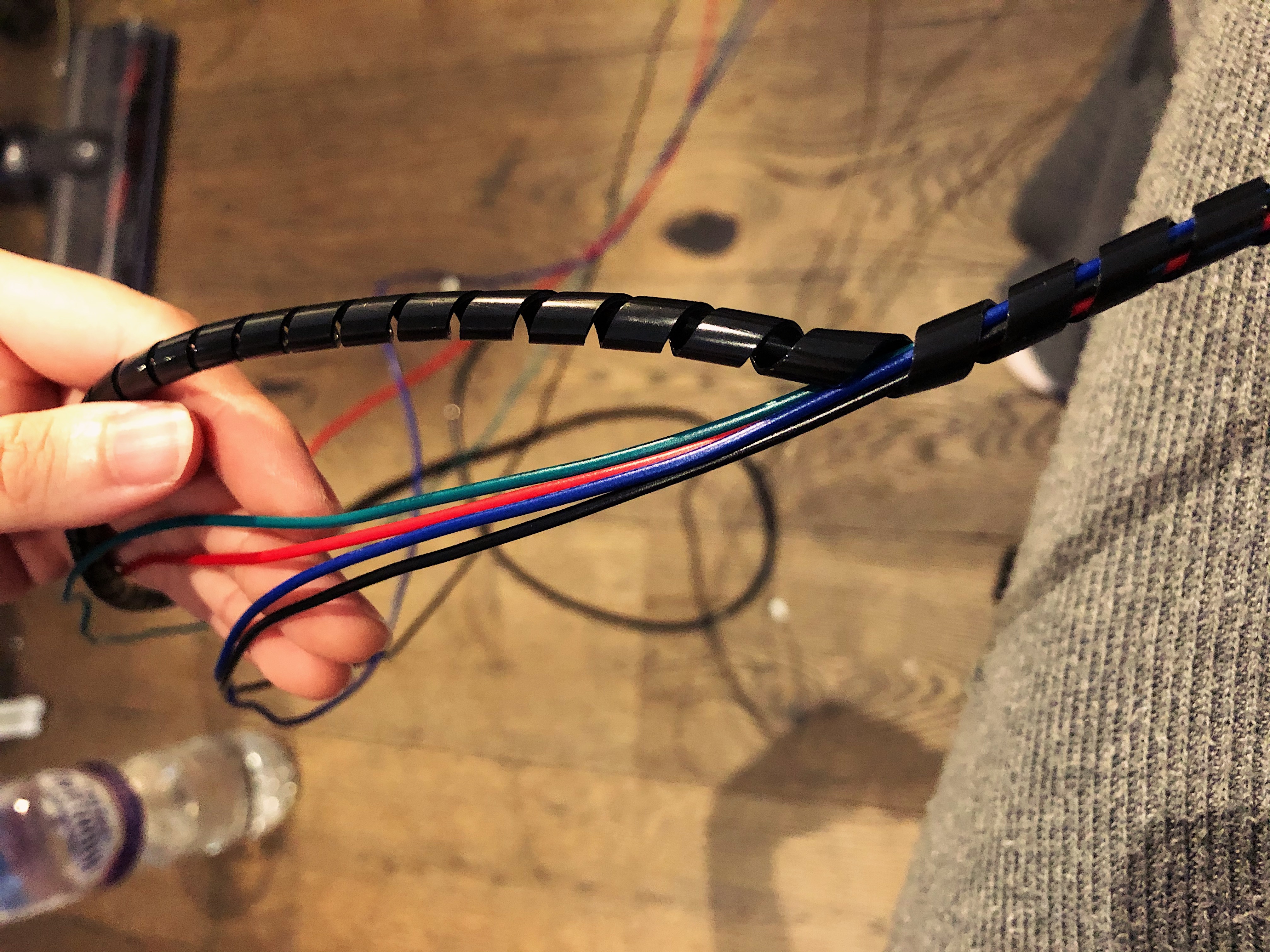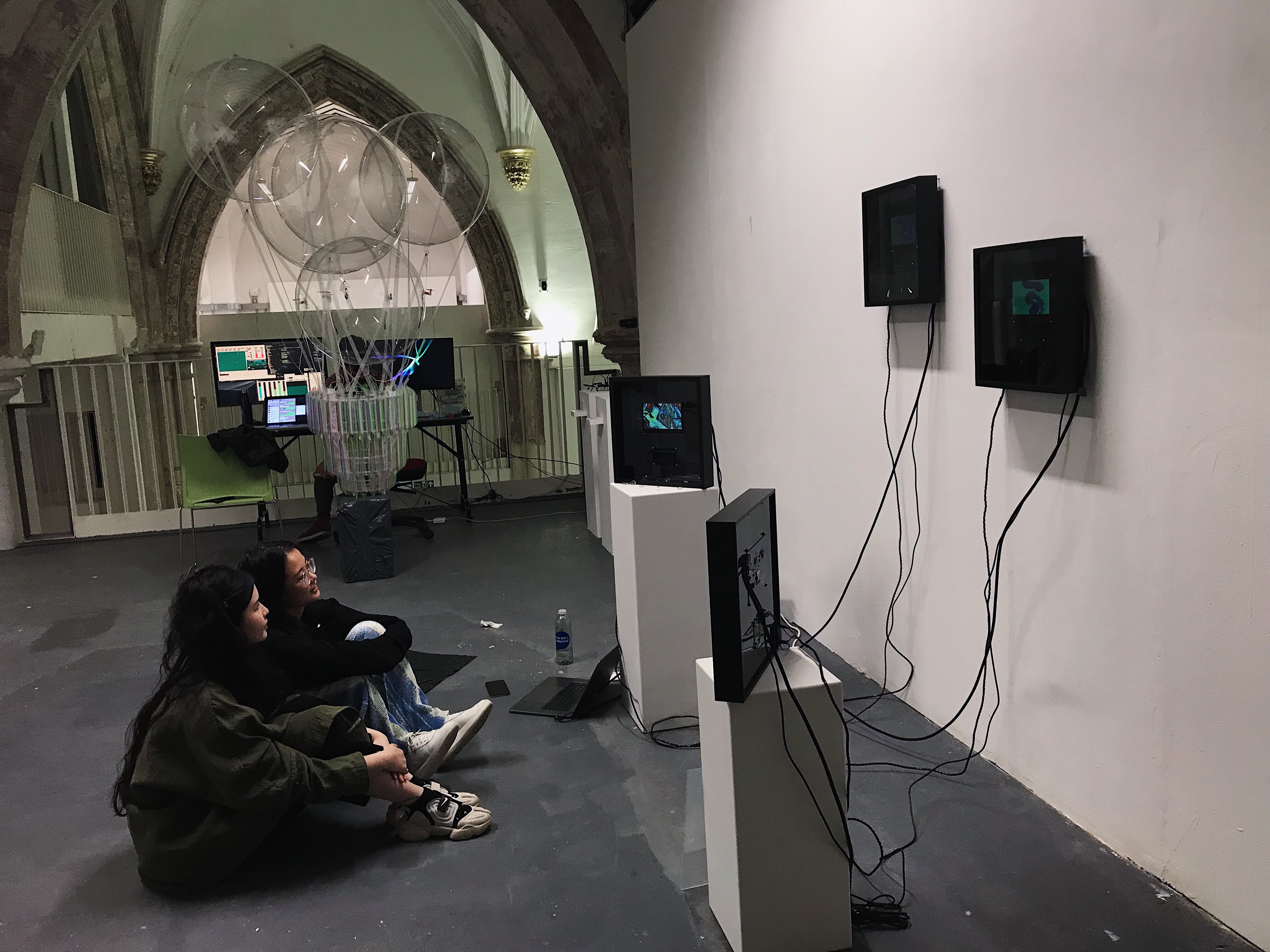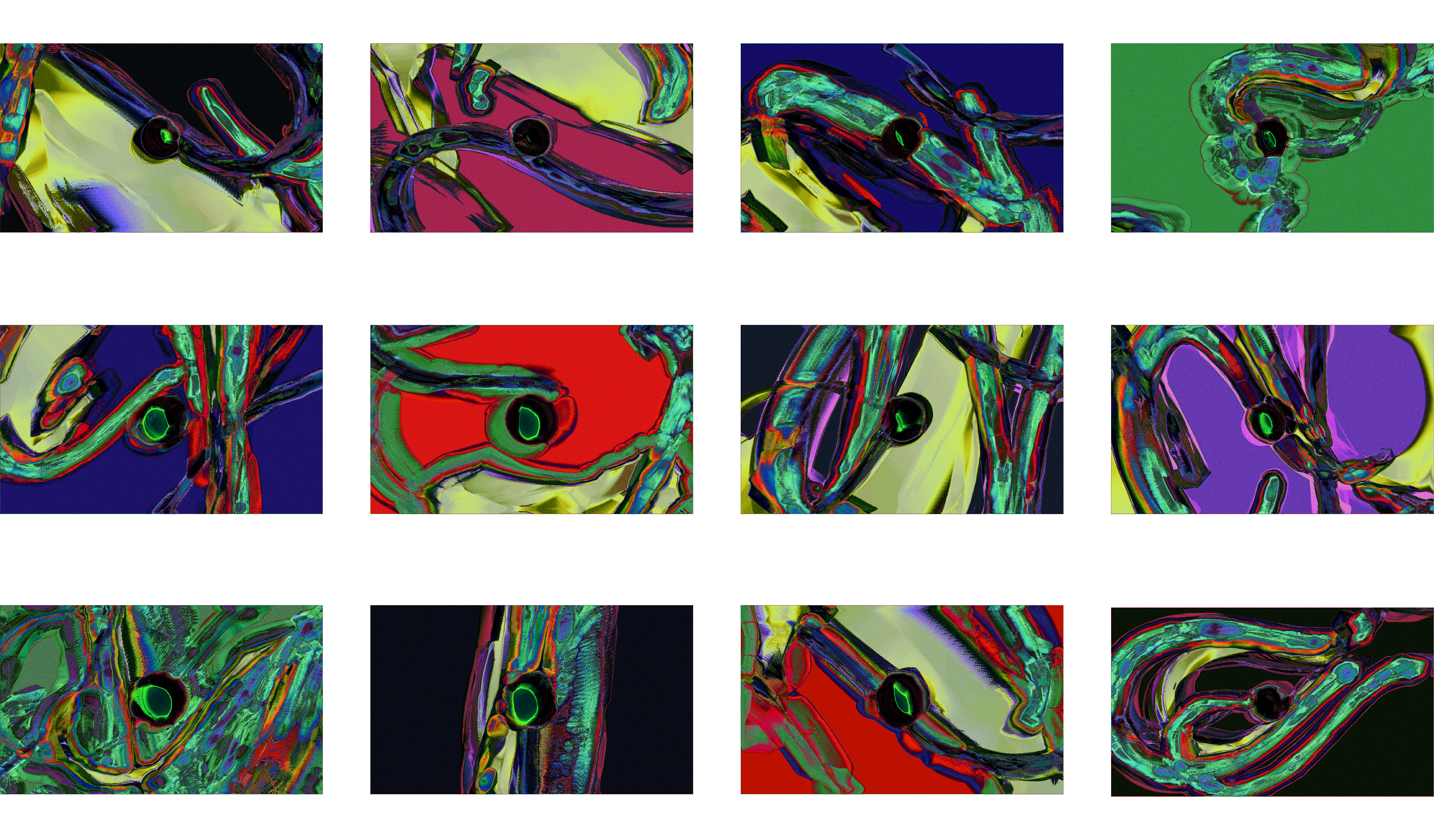Memory Miniature
produced by: Xinyu Sun
Introduction
Memory Miniature is a multi-screen video installation that exploring the mysterious sensation of the Déjà Vu experience, inspired by the artist's personal experience of the Déjà Vu and its features. The Installation is driven by Processing, Arduino and TouchDesigner. The system is formed by generating the random time points and creating the dynamic fading and distorting effect motion graphics. I was trying to carry out an enjoyable sense of mystery in a digital installation. This transient feeling is based on a random hybrid of memories that are similar to what experiencing at present. It is an overwhelming sense of familiarity in an idiosyncratic situation that could not express concretely. Departure from the concept that every fragment in the past might become the elements of the next Déjà Vu experience in the future, I am searching for this fleeting feeling and expects to merge with the memories fragments in the unpredictable moment.
Concept and background research
The artefact ultimately produced is based on the characteristics and the artistic abstraction of déjà vu. Inspired by personal experiences of déjà vu, the mysterious feeling it brings is the original, underlying and motivating intention driving this theme to research and explore artefact creation.
Coincidentally, the déjà vu experience is difficult to explain for most people. It can be broadly summarised as an overwhelming sense of familiarity in an idiosyncratic situation, but in a situation where this feeling should not be familiar, because the things or events people experience in that situation it is actually, in reality, new. Accordingly, déjà vu has been defined as a cognitive neuropsychological phenomenon. It is a sensory feeling that people are experience and only occurs in a specific moment in which it is triggered. For instance, a person can recognise a friend every time when they come across. On the contrary, if you commute along the same road every day, when the déjà vu occurs at a random moment along that road, it would procure the feeling that although the road scene regular as usual, it still feels distinctly different. Another situation is where you never ever visited a certain place, but upon your (first) arrival, you have a strong feeling that you have been there before. In the above examples, a common feature is that you cannot represent the déjà vu experience, ascertain its origin, or even recall it exactly because it is quickly forgotten. In the investigation entitled Stimulus Dimensions Which Appear to Trigger a Déjà Vu Experience, Brown et al. (1994) utilised two different methods to ask participants about what triggers their déjà vu experiences. First, participants were asked to explain whether their typical déjà vu experience included any or all of six specific elements: physical setting, other's spoken words, own spoken words, other's actions, own actions, and objects. Brown et al. (1994) gave respondents a choice of three adverbs by which to express the degree to which participants agreed with the statement, which are ‘always’, ‘sometimes’, or ‘never’. Participants were also asked to provide a brief description of their recent déjà vu experience. Perhaps unsurprisingly, the evaluation records demonstrate that the factors inherent to the physical environment are the most likely stimuli to trigger a déjà vu experience. In more than half of the short descriptions provided by the respondents, their déjà vu experience was triggered by the elements present around them, in the physical world.
Déjà vu experiences are accordingly associated with the brain's reading of memory and the process of reading specific memory details; moreover, the similarity of recognition errors also seem to precipitate déjà vu experiences among people. There are three situations where this phenomenon is most likely to emerge. First, the memory did indeed (that is, in reality) happen. However, the brain cannot read other associated or otherwise related memories, such as the time and related times before and after a specific event or situation. The second situation is that the memory (i.e. context of the déjà vu experience) has never happened, yet nonetheless is in all respects similar to random real memories and is allocated by the brain as such. However, because of its high similarity to a certain episodes retained within human memory, it is mistaken for the same (real) memory contained within the human brain. The last situation is whereby the memory has also never happened in reality, but nevertheless, at the same time, it is highly similar to virtual memory, such as a scene witnessed in a movie, game, or photo (i.e. as received from some other fictional medium).
After human's memories are processed and stored, only some specific elements (contemporaneously analogous to ‘keywords’) are left, such as a general outline of a scene, a sentence, an elusive yet undeniably extant ambiguity, and a tone. Once the future experience meets these fragments (of memory), the sensory strata within memory stores will be stimulated, while the network of memory-reading neural synaptic connections sometimes throw out errors, which is the primary reason why people cannot trace the source and time of the pseudo-memory (i.e. the déjà vu experience). This results in the characteristic feeling of experiencing the current situation at a prior point in time, despite realising that this presently experienced moment is, in truth, entirely new. What places have we been to? What did such spatial areas look like? What was the smell of the food? We can recollect past events via our memory, and the fragmentary nature of memory vis-à-vis different sensorial impressions or feeling is the most essential component part which forms our déjà vu experience. In short, déjà vu can be seen as a false sense of familiarity, rather than a top-down contextual information cascade. This discovery indicates that this cognitive feeling is, in fact, false. Familiarity is akin to a signal, which means that there is something in our memory system that act based on our actions with familiar feelings, which in turn guides our subconscious memory search and recall. As in the experience of a déjà vu, people can identify things that are familiar, but they cannot retrieve any information about why they are familiar.
Based on the research above, the déjà vu experience is like an error when the brain processes a new event and confound with random memories pieces. My concept of this artefact is every memories fragment and piece might become an element of my future déjà vu experience. So the initial idea is generating abstract graphics which imitating the feeling of déjà vu based on every single time point that I have experienced since I was born. Secondly, I can not match the specific memories and time when I merged with the hybrid brought by déjà vu. Those fragments and feelings were transient so that the time point will be randomly for the TimeGenerator. Moreover, the déjà vu experience tends to be triggered by objects in the physical world, which is colourful and variable. Based on the feature and personal experience of déjà vu mentioned above, I designed the installation graphics to colourful, intertwining, dynamic solid figure,and the size, colour and wondering position is controlled by the numbers of time.
Artists and Artworks Research
I was inspired by the paintings created by Tao Xian. She utilises digital technology to process photos and then uses oil paintings as a carrier. By distorting colours and shapes, her paintings seem to slowly fade. However, they are still preserved in memory. The visually striking colours contrast with the soft and ambiguous shapes, like malfunctioning electronic devices with poor electrical contact. Her paintings further seem to freeze those malfunctioning and distorted moments. As the paintings combine the names of their integrated works, they offer the audience a boundless opportunity to exercise the imagination. Xian’s paintings evidentially seek a balance between the concrete and the abstract. The scope of her paintings depend upon her perception of the theme and subjectivity of expression at the moment of creation. Tao Xian attemps to explore the following questions in her artistic practice: How does the two-dimensional screen present all the information of the three-dimensional and even the four-dimensional world, including the passage of time? Is there any doubt about the authenticity of this information? This is very similar to the question that I need and intend to explore.
The second work that inspired me is the Chaosmos created by Masayuki Kawai. I saw this work in Art Basel Hong Kong 2018. Masayuki Kawai created video works in a unique and philosophical style. Under the theme of Chaosmos - the fusion of chaos and cosmos - works using ‘video feedback’ created by analogue devices are showcased. The images were generated in real-time with closed circuits of analogue video devices. The installation series is mixed material that contains monitors, cables, steels, woods. The collision between different materials is organic, representing the connection between digital objects and the physical world. He understands the ‘analogue’ as the essence of video, which is subject to every chance and change, opposing it to the digital, which formulaically utilizes signal while excluding noise. Kawai’s works are a kind of living system, changing infinitely and never repeating an instant. They elicit the pleasure of eternally mutating images that appear as cosmos in the finite world yet are open to infinite chaos.
For graphics and the installation design, the work of Tao Xian and Misayuku Kawai inspired me a lot. My work focused on the exploration of sensory experience. My interest in the phenomenon of déjà vu derives from the mystery that it brings about regarding the known and the unknown. This fleeting feeling is like my perception; it randomly flows between my old memories and new things. And my idea was to combine the digital screen and mixed material. My work utilises the screen as a medium. The graphic explores the relationship between time, feeling and the physical world inside the frame of déjà vu.
Design and process
The memory is dynamic and varying, and the déjà vu experience is an activity of the brain process. I design the graphics in the form of simulating neurotic connecting. The rotating solid figure will be crossing and intertwining with each other. I chose photo frames for the installation building to hold the LED and LCD screens because people tend to put and restore their previous memory in photo frames for collection and recall. The déjà vu experience is a little surprise also an enjoyable mysterious sensation for me. It happened at an unpredictable moment and can not be collected. So I want to restore this fleeting feeling in a decent holder. I used dark grey tint acrylic to fix the screens by applying laser cutting to cut the hole. The tinted acrylic brings a delicate texture. The audience can see the wires behind the photo frame by its transparent look, adding details to the installation. I used a spiral wire tune to enclose wires for the details and used unitive colour wires for the installation.
For the exhibition setting, I hung two frames on the wall in different heights and placed the other two on different height plinths in front of the wall for aesthetic purposes. I use the laser cutter to produce some solid numbers and put my birthday numbers the day before the degree show on two plinths, scattering on and beside the frames, which is for decoration and acts as a hint of my concept. I set a chair in front of my installation. Audiences can sit down and watch my work for a while and getting a mesmerizing experience.
Technical
Processing, Arduino and TouchDesigner drive the Installation. The core of the artwork is a TimeGenerator. The programme will generate a new time point every thirty seconds between the period, which is from my date of birth to the date before the degree show. The time point contains day, mouth, year, Also second, minute, hour. Each number of time points will control the size, colour and translation of the position of the solid figure. The graphics will be randomly generated and changed while the time point changed.
The raw graphic will be generated in the Processing programme and passed to TouchDesigner to add fading and distort the effect. At the same time, the Processing programme will pass the error and glitch numbers to Arduino and display them on LCD screens. The effect and acid colour generate in TouchDesigner by mainly using Edge, Slope and Feedback Loop. The movement was setting by adjusting details of Noise. I used Edge to detect the Edge of shapes, made the Feedback connected to the Composite and linked to the target layer, then used the Level to make things disappear. Finally, plugging all the items into the Mono and Colour Noise generates an abstract and acid-colour look.
Future development
For future development, I plan to build a more extensive scale installation using monitors and mix materials, and It might be made in a chaotic layout. Or maybe a small installation room full of screens.
Self evaluation
I am glad of the degree show setting, two frames we're hung and the other two place on the plinths, setting them to different heights to reach the aesthetic purpose. Many audiences sit on the chair spontaneously while watching my work. Sitting there and watch the varying graphic was really enjoyable. The ointment is one of the screen's lights was not as bright as others and can not adjust it brighter. I found this problem after the show began. I think I should be more careful while installing the work.
Image reference
TAO XIAN, The Rhythm of Breath, 2020, available at: https://asianartplatform.com/artwork/the-rhythm-of-breath/
TAO XIAN, North Korea Train, 2016, available at: https://asianartplatform.com/artwork/north-korea-train/
TAO XIAN, Silence A Beat #2, 2020, available at: https://asianartplatform.com/artwork/silence-a-beat-2/
TAO XIAN, Inverted Fiction #2, 2016, available at: https://asianartplatform.com/artwork/inverted-fiction-2/
Bibliography
Brown, A. S. (2004) The déjà vu experience. New York: Psychology Press (Essays in cognitive psychology).
Moulin, C. (2017) The Cognitive Neuropsychology of Déjà Vu. 1st edn. Milton Park, Abingdon ; New York, NY : Routledge, 2017. |: Routledge. doi: 10.4324/9781315524931.
Cleary, A. M. and Claxton, A. B. (2018) ‘Déjà Vu: An Illusion of Prediction’, Psychological Science, 29(4), pp. 635–644. doi: 10.1177/0956797617743018.
Cleary, A. M. et al. (2012) ‘Familiarity from the configuration of objects in 3-dimensional space and its relation to déjà vu: A virtual reality investigation’, Consciousness and Cognition, 21(2), pp. 969–975. doi: 10.1016/j.concog.2011.12.010.
Cleary, A. M. and Claxton, A. B. (2015) ‘The tip-of-the-tongue heuristic: How tip-of-the-tongue states confer perceptibility on inaccessible words.’, Journal of Experimental Psychology: Learning, Memory, and Cognition, 41(5), pp. 1533–1539. doi: 10.1037/xlm0000097.
Artist Tao Xian Uses Technical Glitches to Reshape Our Views on Identity. Available at: https://www.youtube.com/watch?v=LSJmaWa8snQ (Accessed: May 10, 2021).
Bowers, W. (2019) Dreams, art, and Deja vu - will bowers - medium, Medium. Available at: https://sartorible.medium.com/dreams-art-and-deja-vu-d9dab885b0e5 (Accessed: May 8, 2021).
TOUCHDESIGNER TUTORIAL - GENERATIVE LIQUID PAINTING. Available at: https://www.youtube.com/watch?v=4MD8iZujVsY (Accessed: May 10, 2021).
Pixel Sorting – TouchDesigner Tutorial 16. Available at: https://www.youtube.com/watch?v=xasLIEw23zY (Accessed: May 10, 2021)





































































